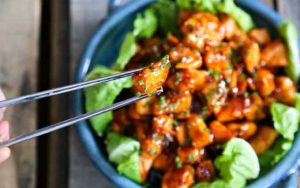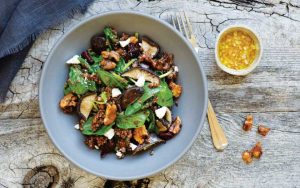Eating a cholesterol-lowering diet during pregnancy may reduce your risks of premature delivery. Studies show that 11 out of 149 women who ate their usual diets delivered preterm compared with only one of 141 women whose diets emphasized fish, dairy products, whole grains, healthful oils, fruit, vegetable, and legumes. The latter group also had lower blood cholesterol levels.
Many foods can help keep your heart and baby’s heart at their best health. Some help lower your blood pressure, while others keep your cholesterol in line. So, be sure to add these healthy foods listed below into your diet, and don’t forget to grab them the next time you are out grocery shopping!
Salmon
This fish is a top choice because it is rich in omega-3 fatty acids. Omega-3s have an anti-clotting effect, so they keep your blood flowing plus they also help lower your triglycerides (a type of fat that can lead to heart disease).
Aim to have at least two servings of oily fish a week. Per serving should be about 3.5 ounces, which is roughly slightly bigger than a computer mouse. If you don’t fancy or are allergic to salmon, try substituting it with tuna, trout, sardine or mackerel.
Walnuts
Nibbling on about five ounces of nuts each week can cut your risks of heart disease in half. Walnuts have a lot of ‘good’ fats. When you use these monounsaturated fats in place of saturated fats, such as butter; you cut your ‘bad’ LDL cholesterol and raise your ‘good’ HDL cholesterol.
Although not as much as fish, they are also a good source of omega-3 fats. In replacement of walnuts, try consuming almonds, cashews, pistachios, flaxseed or chia seeds.
Raspberries
These berries are loaded with polyphenols — antioxidants that mop up damage-causing free radicals in your body. They also deliver fiber and vitamin C, which is both linked to a lowered risk of stroke.
If you don’t enjoy eating raspberries, try replacing them with any berries — strawberries, blueberries, blackberries — are great choices. Fruits and vegetables, in general, are excellent choices because of their nutrients and fibre.
Fat-free or low-fat milk or yoghurt
Dairy products are high in potassium, and that has a blood-pressure-lowering effect. When you choose low-fat or fat-free dairy, you get little to no saturated fat, the kind of fat that can raise your cholesterol.
If you happen to be lactose intolerant and cannot agree with dairy products, do substitute them with fruits and vegetables that have some potassium. Bananas, oranges, and potatoes are especially good sources.
Chickpeas
Chickpeas and other legumes (lentils, other kinds of beans) are a top-notch source of soluble fiber — the kind of fiber that can lower your “bad” LDL cholesterol. If you buy canned beans, look for low-sodium or no-salt-added varieties (sodium can raise your blood pressure). Rinse them in water to wash off any added salt.
Feel free to substitute them with eggplant, okra, apples, or pears as they are also good choices for soluble fiber.
Oatmeal
Oats have a type of fiber (called beta-glucan) that lowers your LDL cholesterol. One and a half cups of cooked oatmeal gives you the amount of beta-glucan you need daily to help lower your cholesterol. You can also find beta-glucan in barley, shiitake mushrooms, and seaweed.
Avocado
These fruits get their creamy texture from “good” (monounsaturated) fats, which lower your “bad” cholesterol.
They also seem to have an anti-inflammatory effect, so you don’t get chronic inflammation that makes atherosclerosis — the hardening of artery walls – worse. Use mashed avocado as a spread in place of butter, or add cubes of it to the salad. As delicious as they are, avocados are high in calories, so keep your portions modest.
Grapes
These juicy fruits have resveratrol, which helps keep platelets in your blood from sticking together. That may partly be why red wine — in moderation — may have some heart-healthy advantages over other types of alcohol. But experts don’t recommend that you start drinking, because alcohol does have some health risks.
Exciting recipes just for you!
Cooking may be tiring, which is why you may decide to eat anything quick and easy. The following are easy to whip up.

Spicy Roasted Chickpea
Ingredients
- 2 cups cooked chickpeas or 1 (15 oz) can
- 1½ tsp olive oil
- ¼ tsp salt
- ¼ tsp black pepper
- ¾ tsp chili powder
- ¼ tsp paprika
- ¼ tsp garlic powder
- a dash of cayenne pepper
Method
- Preheat oven to 425°F.
- Pat the chickpeas dry between two paper towels and be sure to remove any loose skins.
- Pour the chickpeas on a baking sheet lined with parchment paper and mist with olive oil. Use your hands or a spoon to toss the chickpeas.
- In a small bowl, combine the seasonings and whisk to combine. Sprinkle the mixture onto the chickpeas and toss to coat. Bake for 25 minutes, stirring the chickpeas at the 15-minute mark.

Sweet Salmon
Ingredients
- 2 skinned salmon fillets (approx 200g) cut into 4 cm cubes
Marinade
- 1½ tbsp soy sauce
- 2 tbsp ketchup
- 1 tbsp white wine vinegar
- ½ tsp sweet chilli sauce
- 1½ tbsp dark brown sugar
Method
- Place all the ingredients for the marinade in a small saucepan and stir over a gentle heat until the sugar has dissolved.
- Remove from the heat; pour into an ovenproof dish and leave to cool. Add the cubes of salmon fillets and turn to coat them in the sauce. Leave to marinate for at least one hour.
- Preheat the grill and cook the salmon in a baking tin lined with foil for about 5 minutes, turning halfway through and basting occasionally until cooked.
- Remove the salmon from the baking tin and serve on top of a bed of brown rice.

Shiitake Walnut Salad with Quinoa
Ingredients
- 1 cup (250 ml) water
- ½ cup (125 ml) quinoa
- ¼ cup (50 ml) olive oil, divided
- 4 oz (125 g) shiitake mushrooms, stems removed
- 1 clove garlic, minced
- 1 tbsp (15 ml) soy sauce
- ½ tsp (2 ml) each salt and fresh cracked black pepper
- 2 tsp (10 ml) maple syrup
- 1 tsp (5 ml) grainy Dijon mustard
- 8 cups (2 L) arugula or watercress
- 1 cup (250 ml) toasted walnuts, roughly chopped
Method
- In a small saucepan, bring water to a boil. Add quinoa and bring back to a boil. Reduce heat and simmer, covered, until water is absorbed, about 10 minutes. Remove from heat, leave covered for 15 minutes.
- In a large skillet, heat 2 tbsp (30 ml) of the oil over medium-high heat. Add shiitake mushrooms and brown on both sides, about 5 minutes. Add garlic and cook 1 minute. Stir in soy sauce, salt, and pepper. Remove from heat.
- In a small bowl, whisk together remaining oil with maple syrup and Dijon mustard.
- Add arugula and walnuts to hot mushrooms in a pan. Stir in quinoa and drizzle with oil mixture, stirring to combine.
- Serve warm shiitake walnut salad immediately.


